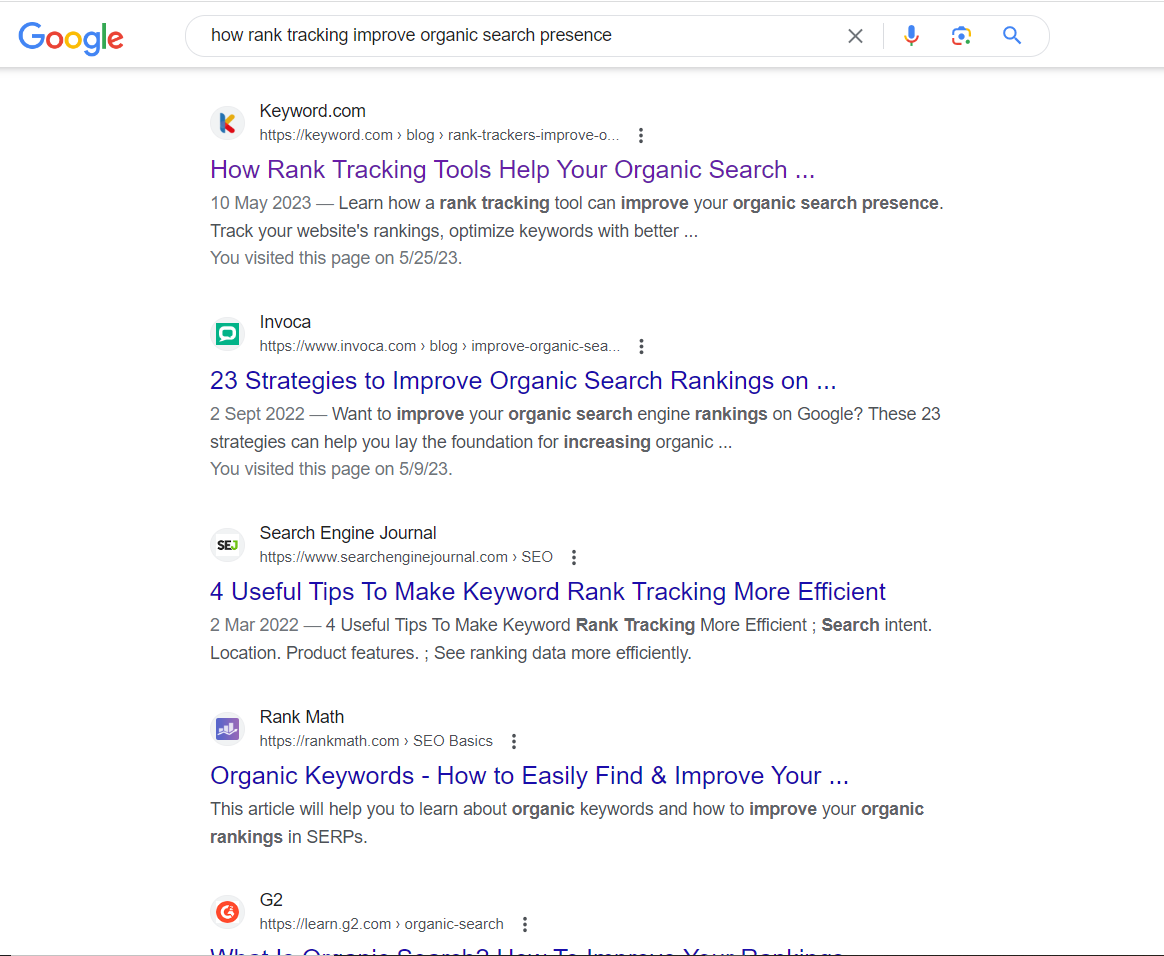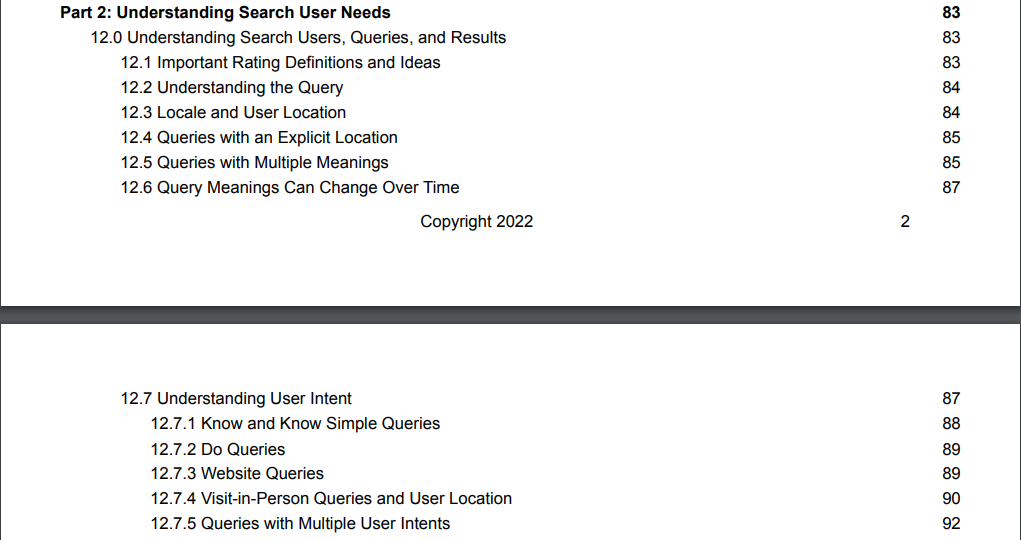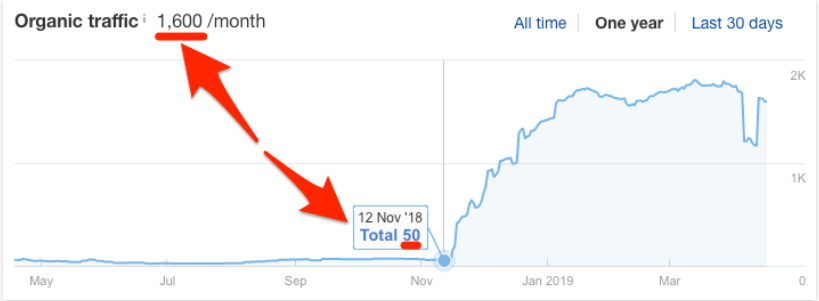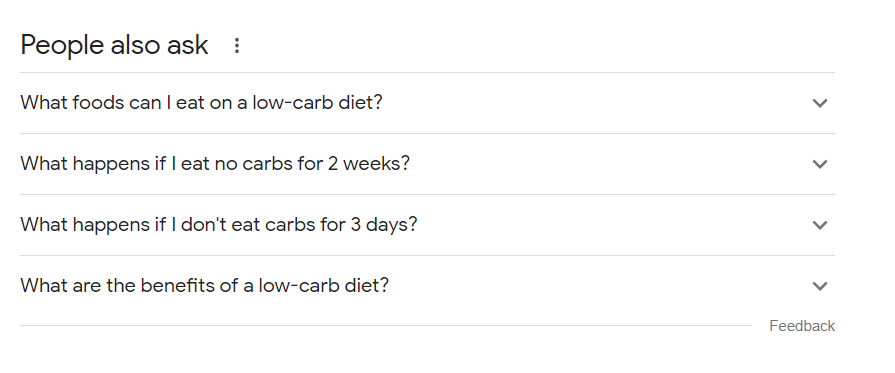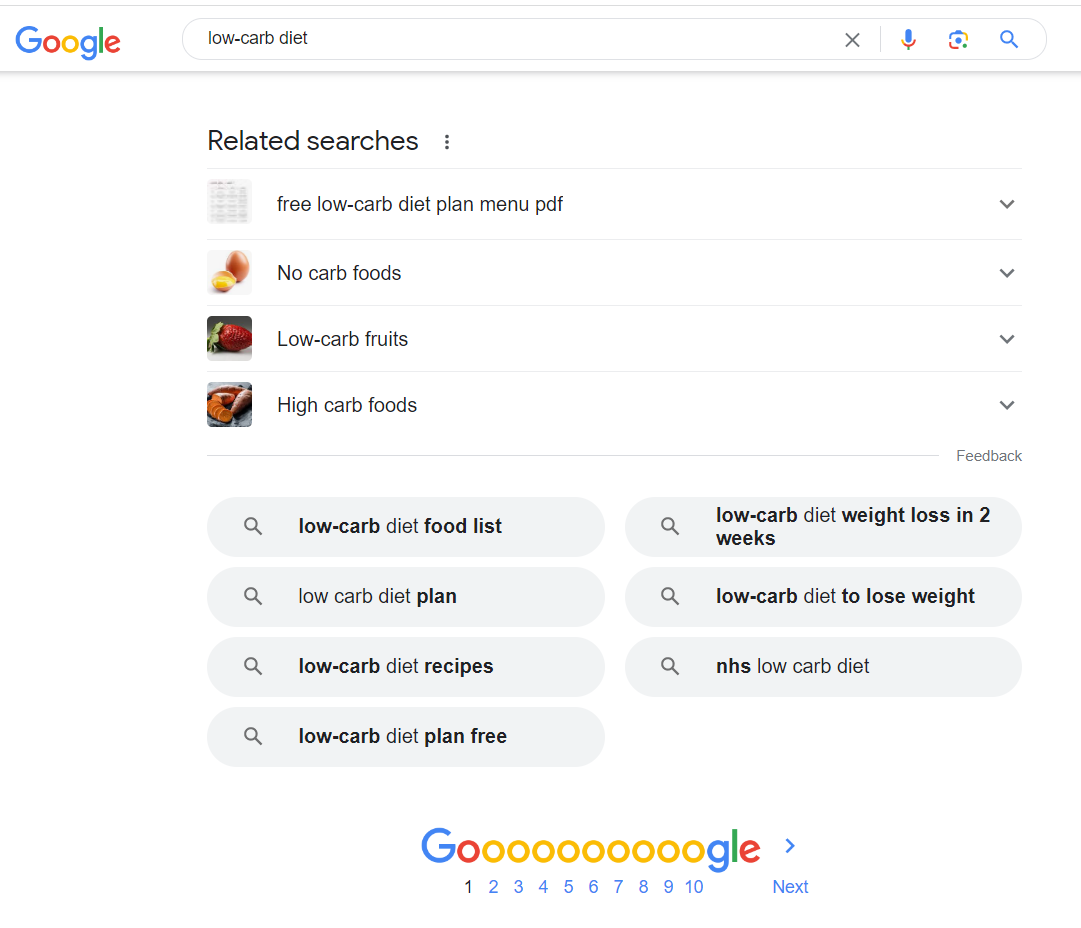Millions of blog posts are created daily, but most struggle to rank for their target keywords despite their stellar content.
Why?
Often, there is a mismatch between their target keywords and search intent.
Every searcher has something specific in mind when they type their search query. It might be an answer to a question, a solution to a problem, or information before purchasing.
No matter the experience and quality incorporated in creating your content, it must be able to provide the exact answer to the searcher’s query to rank on search engine result pages.
In recent years, search engines are obsessed with satisfying user intent. As a result, optimizing search intent has become a primary factor for better visibility on SERPs.
In this article, you will learn what search intent is about, how it changed over the years, and the techniques for understanding it.
What is Search Intent?
Search intent, also known as user intent or query intent, refers to the underlying purpose behind a user’s search query on a search engine. It aims to understand what the user is trying to accomplish or find when searching.
For example:
- You hear about the importance of rank tracking and its impact on improving organic search presence, and now you want to do further research about this concept. So, you head straight to Google and search for a term such as “How does rank tracking improve organic search presence” or “rank tracking and organic search presence.”
- Google provides a list of pages relevant to your search query. Possibly, the first result you clicked looks okay, but you quickly realize it doesn’t emphasize how rank tracking boosts organic search presence.
- You click another result, like Keyword.com, with your search term in its title.
4. You delved into the page and discovered that they spread their tentacles even to sharing practical case studies of brands that skyrocketed their organic search presence with rank tracking.
…which is the exact information you are looking for.
If more people click on the page, get a complete answer to their query, and comment, the page will get a significant ranking boost on the search engine result page.
Search Engines and Search Intent
Search engines strive to provide the most relevant and valuable results based on the user’s intent rather than solely focusing on the specific keywords used in the query.
Google’s search quality evaluator guidelines show how Google prioritizes satisfying searchers’ intent to succeed on their result pages. Just as their primary objective emphasizes providing users with the most relevant, highest quality information based on user search queries.
Let’s examine some core Google updates that reflect the search engine’s focus on satisfying searchers’ intent.
– RankBrain (2015)
Google RankBrain update focuses on creating content that matches users’ intent and is optimized for conversational speech.
– Broad Core Algorithm Update (2018)
This update brought the concept of E-A-T, emphasizing creating content for users.
After the update, Google’s Danny Sullivan said,
“Want to do better with a broad change? Have great content. Yeah, the same boring answer.”
– BERT (2019)
Google BERT update allowed Google to understand keywords with conversational intent better. The focus is to improve the understanding of consumer intent by ensuring content addresses the users’ questions and is optimized accurately.
– Broad Core Algorithm Updates (2020)
According to Ryan Jones, Search Engine Journal contributor, “Google aims to serve content that provides the best and most complete answers to searchers’ queries. Relevance is the ranking factor that will always win over all others.”
Again, Bing Webmaster Guidelines prioritize satisfying user intent as a primary parameter to rank pages on their search results.
“Relevance refers to how closely the content on the landing page matches the intent behind the search query.”
Even though backlink is a crucial ranking factor, if your content doesn’t satisfy the user’s intent, it won’t rank. In fact, in 2019, top SEO specialists, including Josh Hardwick and Viola Eva, highlighted search intent as the most impactful ranking factor.
Here is a case study from Ahrefs that validates this fact.
Ahrefs experienced over 3100% increase in traffic for one of their pages by optimizing for search intent.
“In 2016, we studied on-page SEO across two million keywords and created an article after the research.
The post was good but never ranked for anything or got much traffic.
So, we looked at the top-ranking pages to determine why this was and soon realized that search intent was the issue.
Basically, searchers didn’t want to see a study; they wanted an actionable guide.
Now the post ranks in the top 5…
…and traffic has increased by 3,100%!
Types of Search Intent:
1. Informational Search Intent
Informational search intent is basic/foundational searches. Often these searches are done by users at the beginning stage of the buyer’s journey. They use words like:
- Who
- What
- Why
- How
- Where
Here are some examples of informational search intent:
- What is an SEO API?
- How to prepare a hamburger
- Who is the President of the United States?
- How to get to California
Search engines often provide answers to these search queries on the result page through featured snippets, knowledge panels, and more. For instance, the answer to “What is an SEO API” is covered in the featured snippet.
How to optimize for informational search intent
- Ensure your website is easily accessible and well structured for a better user experience.
- Search and optimize relevant questions people are asking around your target keyword (we will delve deeper into this point later in this article).
- Provide valuable content that thoroughly answers the searcher’s query.
2. Navigational Search Intent
The name says it all. These search terms are used by searchers looking for a specific page. Examples are keyword.com subscription, Keyword.com sign-up, and Gmail login.
These keywords are branded, and they help searchers navigate certain areas of a webpage.
3. Commercial Search Intent
Keywords with commercial intent show users’ research for options for a product or service. These search terms often contain “buy” and “purchase.” These keywords are used by users in the middle of the buyer’s journey. This search intent lies between informational and transactional intent.
Examples of keywords with this search intent include:
- Restaurant near me
- Best watches for men
- Keyword.com alternatives
- Buy cheese near me
4. Transactional Search Intent
Searchers that use keywords with this search intent are in the last phase of the buyer’s journey. They have a specific product or service in mind but desire further information.
These are keywords your prospects use when they are ready to convert. Examples of keywords with this search intent include:
- Keyword.com free trial
- Keyword.com pricing
- iPhone 11 pro max price
- COD download
How Search Intent Changed Over the Years
Over the years, search intent has evolved significantly due to technological advancements, changes in user behavior, and the development of search engine algorithms. Here are some key ways in which search intent has changed:
1. The Shift from Keyword-based Search
In the past, search engines relied heavily on matching keywords in a search query with keywords on web pages. The more you use a keyword in your article, the higher you rank on SERPs (an old-time practice where keyword stuffing was a white-hat SEO strategy).
However, with the rise of semantic search, entity-based SEO and search engines’ update tagging keyword stuffing as spam, search engines now aim to understand the user’s intent beyond literal keyword matching.
The semantic search considers context, user behavior, and word relationships to provide more accurate and relevant results.
Entity-based SEO describes a search engine’s attempt to generate the most accurate search engine results by connecting user intent, context, and the relationship between words.
Related:
How to Use Entity SEO to Rank Higher – A Definitive Guide
How to see Google search results for other locations
What is kgr? How to Calculate Keyword Golden Ratio?
The connection between these two concepts has demystified the core reason behind users’ searches, changed the algorithm for better search result ranking, and produced more relevant search results based on searchers’ queries.
2. Shift Towards Long-Tail Keyword
According to Backlinko’s analysis of over 300 million keywords, 91.8% of all search queries are long-tail keywords. 92% of all keywords that people type into search engines are long-tail.
Initially, search queries often consisted of short and generic keywords. However, as search engines became smarter, users started using more specific, relevant, and longer search phrases, known as long-tail keywords. This shift reflects a desire for more precise and targeted results, indicating a deeper understanding of search intent.
3. Rise of Voice Search
The advent of voice assistants and voice-activated devices has transformed how people search. Voice searches are more informational and natural, often resembling complete sentences or questions. As a result, understanding informational intent has become crucial for search engines and marketers.
Again, with the increasing use of voice search, 82% of searches via voice search use long-tail keywords. Hence making it easy to input their query with specificity and get relevant results for their search.
4. Mobile and Local Search Intent
A recent report shows that 60% of searches are done on mobile devices, and 90% are for local information.
With the proliferation of smartphones, the volume of mobile searches has surged. Mobile searches often have a local intent, where users seek information relevant to their immediate vicinity, such as “restaurants near me” or “nearest gas station.” This shift has necessitated optimizing content and websites for local search intent.
The evolution of local search intent has prioritized the implementation of transactional search intent.
With a 500% increase in “near me” searches in the past few years, businesses have moved from optimizing only informational intent to delving deeper into transactional search intent. For instance, a restaurant’s blog will contain content about food recipes and the best places to get the food recipes featuring their restaurant.
5. Personalized Search Results
Search engines have become better at personalizing search results based on location, search history, preferences, and user behavior. As a result, search intent is now interpreted in a more personalized manner, providing tailored results that align with an individual’s specific needs and interests.
6. Integration of Rich Features and Snippets
Search engine result pages (SERPs) now frequently include rich features such as featured snippets, knowledge panels, images, videos, and more. These features cater to different types of search intent, allowing users to obtain quick answers, visual content, or interactive results without clicking through to a website. For instance, featured snippets capture informational search intent, often question-based.
Search intent has become more nuanced, context-driven, and focused on delivering a better user experience. Search engines strive to understand user intent more sophisticatedly, aiming to provide relevant results beyond simple keyword matching. This evolution has pushed marketers and content creators to optimize their strategies to align with the changing landscape of search intent.
Tools and Techniques for Understanding Search Intent
The latest data shows that Google processes over 99,000 searches every second, equivalent to more than 8.5 billion daily searches. This indicates that search engines contain billions of search queries with different search intents.
Interestingly, the algorithm studies different search queries and uses the information to improve its search results. This improvement and the implementation of various features make it easy for marketers to understand other search intent.
1. Let’s check a few SERP features that make understanding search intent easy.
Google’s Autosuggest
Enter your primary keyword into Google’s search box, and you will automatically see a drop-down of top searches people made around that keyword.
From the list, you can understand what people are looking for around that topic and create valuable content rather than an A/B kind of content.
Top Search Results
Google prioritizes providing its users with the most relevant information. So they rank sites primarily based on relevance, authority, and value.
That means sites ranking on the first page most seemingly meet up with searchers’ intent and search engine standards.
You can analyze the first five results to examine the keywords they targeted, the type of content your target audience is looking for, and more.
People Also Ask Segment
Questions are an excellent way to check people’s intent around a query. Find out questions people are asking around your target keywords by analyzing the People Also Ask segment of its result page.
For instance, the People Also Ask segment for the “low-carb diet” result page shows questions with informational intent. Searchers are looking for more information about that topic. Creating valuable content that provides detailed information about the topic puts your site on the verge of ranking.
Related Searches
The related searches segment also provides keywords people use around your target keyword.
You will find this segment at the bottom of the result page.
2. Customer Interviews
John Ozuysal, Founder of House of Growth, says,
“I like to ask my customers to share their screens and walk me through their journey to find solutions to their problems. By understanding how they do their research on Google. I understand their search intent and see my competitors on each step of the buyer journey.”
Also, study your customers’ feedback and surveys to understand their search intent better.
3. Analyze Social Media and Online Forums
Paying attention to questions can give you ample information about what your audience is looking for.
Go to social media platforms like Facebook, LinkedIn, and Twitter to examine questions your audience is asking about your target keyword.
Also, analyze other social networks with forum-style discussion structures like Quora and Reddit. These platforms feature hundreds of questions people ask about different topics.
4. Analyzing User Behavior and Search Data
Web analytics and user behavior tracking are crucial to understanding search intent and optimizing digital marketing strategies. You can gain valuable insights into how your users interact with your website, identify patterns and trends, and make informed decisions to enhance their online presence.
You can analyze your Google Analytics to examine your users’ behavior.
Google Analytics provides detailed insights into your website traffic, user behavior, and conversion tracking. Its range of reports and features helps you track and analyze user interactions, identify key performance indicators (KPIs), and measure the effectiveness of marketing campaigns.
5. User Intent Research Tools
Research your audience’s keywords and phrases to find information about your target topic. Tools like Google Keyword Planner, Google Trend, keyword.com, and more do the work.
For example, Keyword.com has a keyword suggestions feature that automatically lists related keywords around your primary keyword. Additionally, this tool works as a rank tracker software that provides accurate rank tracking of your keywords on search engine result pages.
It’s a double win for you! Try any plans today with an SEO glossary bonus that simplifies jargon-heavy words and phrases in SEO!
Why Should You Be Obsessed About Search Intent
Improve User Experience
Satisfying search intent addresses the needs and expectations of the users when they perform a search. When a user enters a query into a search engine, they have a specific intention or goal in mind. It could be seeking information, finding a solution to a problem, purchasing, or any other purpose. Satisfying search intent aligns with the user-centric approach, enhancing the overall user experience and fostering positive interactions with search engines and websites.
Higher Search Engine Rankings
Times have changed. Ranking on search engine result pages used to revolve around keywords only, which often led to keyword stuffing. That’s why site owners overuse keywords to maneuver their way up the SERP. This practice fostered creating content for search engine bots rather than humans, with low-quality content dominating the result pages. However, search engines got intelligent by prioritizing search intent as a primary factor to rank on result pages. Your content should focus on providing well-detailed and relevant answers to user queries, and you will rank better.
More Targeted Content Creation
Understanding search intent prevents being a generalist. You know your audience’s needs and provide specific and detailed answers that meet them
Enhanced Conversion Rates and Business Growth
When you create content that meets your searchers’ needs, you make your site more trustworthy and will more likely win their confidence to take further action.
Final Words
You already know how to find search intent. Now give your audience what they want!
Create your content in a way that tells searchers. “This page solves every potential problem when searching for that exact keyword,” not “a page with the words you are searching.”
What next? Relax on your cushion with coriander juice tracking the position of your page on SERP with Keyword.com.
